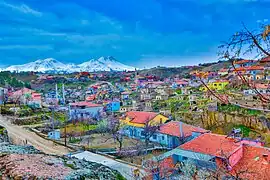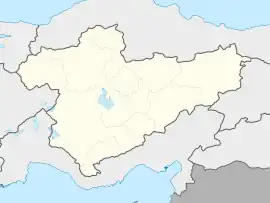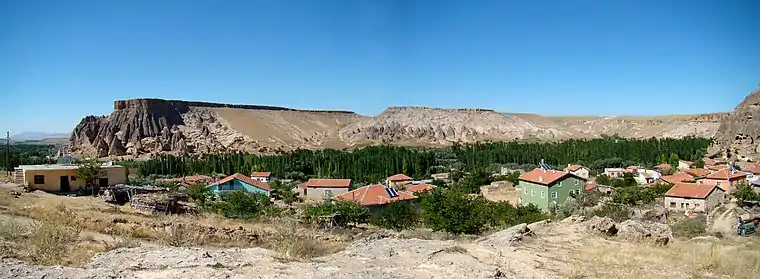Ihlara | |
|---|---|
 The town of Ihlara | |
 Ihlara Location in Turkey  Ihlara Ihlara (Turkey Central Anatolia) | |
| Coordinates: 38°14′N 34°18′E / 38.233°N 34.300°E | |
| Country | Turkey |
| Province | Aksaray |
| District | Güzelyurt |
| Population (2021) | 2,289 |
| Time zone | TRT (UTC+3) |
| Area code | 0382 |
| Website | www |
Ihlara, formerly known as Chliára (Cappadocian Greek: Χλιάρα; Latin: Chliará) is a town (belde) and municipality in the Güzelyurt District, Aksaray Province, Turkey.[1] The population is 2,289 (2021).[2] It is situated at about 40 km (25 mi) from the province seat of Aksaray and near the town of Güzelyurt. The township is famed for the nearby valley of the same name, Ihlara Valley, which is a 16 km (10 mi) long gorge cut into volcanic rock in the southern part of Cappadocia, following several eruptions of Mount Erciyes. The Melendiz River flows through the valley.
The Ihlara valley consists of 14 km along the north-south Melendiz River, which runs from Selime to Ihlara village. Sixteen of the valley's 105 churches are open to visitors, and most of these are within 1 km of the official valley entrance in Ihlara. The first one you are likely to see is Ağaçaltı Kilise (Church Under the Trees), at the base of the stairs leading into the valley. Spectacular blue and white angels encircle the Christ figure on the well-preserved dome. Another 30m south past the Ağaçaltı (to the right after descending the entrance stairs, away from Belisirma) lies the Ptirenllseki Church, whose faded walls enclose the many martyrs of Sivas. The Kokar Kilise (Odorous Church), 70m farther along, celebrates biblical stories with colorful frescoes and ornate geometrical ceiling crosses.[3]
What makes the valley unique is the ancient history of its inhabitants. The whole canyon is honeycombed with rock-cut underground dwellings and churches from the Byzantine period built by the Cappadocian Greeks. These local people were forced to leave the area and move to Greece in the 1923 Population exchange between Turkey and Greece.[4][5]
Etymology
The town of Ihlara had formerly been known as Chlorus or Chlorós (Ancient Greek: Χλωρός) during the Roman and Byzantine period. This name was later rendered as Chliara (Cappadocian Greek: Χλιάρα; Latin: Chliará), which later got mutated to Ichlara, and then to its present name, Ihlara.[6]
Features
It is 40 km from Aksaray.
Ihlara Valley is a canyon valley formed as a result of stream erosion by lava sprayed from Hasandağı volcano. Melendiz Stream, at the end of a process of millions of years, created this canyon-like valley that is 14 kilometers long and reaches 110 meters in height. The Melendiz Stream, which led the canyon through these cracks to take its current form, was called "Potamus Kapadukus", which means Cappadocia River in ancient times.
The 14 km long valley starts from Ihlara and ends in Selime. Melendiz Stream meanders through the canyon. The length of the stream, which makes more than 26 meanders between Ihlara and Selime, is 8 km, but in reality it reaches 13 km. The height of the valley is 100 –150 m in places. There are countless shelters, tombs and churches carved into the rocks throughout the valley. The decorations in the churches in the Ihlara Valley started in the 6th century and continued until the end of the 13th century.
Some shelters and churches are connected by tunnels, as in underground cities.
Churches
Due to the valley's plentiful supply of water and hidden places, this was the first settlement of the first Christians escaping from Roman soldiers. In the Ihlara Valley there are hundreds of old churches in the volcanic rock caves. The best-known churches are Ağaçaltı Church with cross plan, Sümbüllü Church, Pürenliseki Church, Kokar Church, Yilanli Church, Karagedik Church, Kirkdamatli Church, Direkli Church, Ala Church, Kemerli Church and Egritas Church.
Churches located along the valley can be divided into two groups:
The murals of the churches close to Ihlara have an eastern influence, far from the Cappadocian art.
The areas near Belisirma are decorated with Byzantine type wall paintings.
The number of inscriptions known from the Byzantine Period in the Ihlara Region is quite low.
The Seljuk Sultan II. Mesud (1282 -1305) and Byzantine emperor II. There is an inscription on a 13th century fresco containing the names of Andronikos.
This inscription proves the existence of the tolerant administration of the Seljuks, who held the region in their hands. Among the churches whose history has been determined:
Pillared Church (976-1025) Pürenli Seki Church belongs to the beginning of the 10th century and the 12th century. It belongs to the years of Saint Georges (1283-1295). The Dark Castle Church is dated to the 10th-11th centuries. In the middle of the 10th century, new churches were built in the Ihlara region after the Byzantines recaptured the Taurus and Cilicia regions.
Bahaeddin Samanlığı Church Hyacinth Church Mast Church Examples of Byzantine art in the early 11th century:
Ala Church Canli Church (Akhisar) Karagedik Church Some Byzantine type paintings were added to the old churches later on.
This behavior ends with the arrival of the Seljuk Turks in the 11th century.
But the religious life in the region continues. The church life in the region ends with the population exchange in 1924.
Religious Life
Due to its geomorphological features, the Ihlara valley has been a suitable retreat and place of worship for monks and priests.
Aksaray has been an important religious center in the early years of Christianity.
Sect founders such as Basilus of Kayseri and Gregorius of Nazianzos were born in the 4th century. They were also raised here.
They determined the rules of a monastic life separate from the Egyptian and Syrian system.
Thus, the Greek and Slavic system was born.
Although the Egyptian and Syrian priests cut off their relations with the world, the priests of Basilus and Gregorius did not cut off their relations with the world. The place of this new understanding was Belisirma.
Gregorius put forward ideas that strengthened the views of the Nicaean meeting in the discussion of the deity of Jesus by bringing a new explanation to the belief in the trinity. Thus, he became a leading saint in the history of Christianity. The rocky region where Gregorius grew up (Belisırma, Ihlara, Güzelyurt (Gelveri)) became a group of churches carved into the rocks, in line with the monastery spirit.
When the defensive fortresses in Hasandağı resisted the Arab raids, these churches continued to be active centers of worship.
Islam
Although churches and Christians are in Ihlara, Muslims are common religious people there, which is why the municipality have a muezzin (announcer) in the minaret in the mosque Yeditaş Cami with speakers to say the Adhan to announce prayer for Muslims.
Yeditaş Cami consists of a prayer hall, with walls that depict the 99 names of Allah. A fountain with drinkable water with Arabic text that says the Basmala. A minaret with a muezzin to announce prayer for the Muslims in the municipality.
References
- ↑ Belde, Turkey Civil Administration Departments Inventory. Retrieved 15 January 2023.
- ↑ "Address-based population registration system (ADNKS) results dated 31 December 2021" (XLS) (in Turkish). TÜİK. Retrieved 12 January 2023.
- ↑ "Ihlara". Archived from the original on 2018-11-16. Retrieved 2017-03-08.
- ↑ Darke, Diana (2011). Eastern Turkey. Bradt Travel Guides. pp. 139–140. ISBN 978-1-84162-339-9.
The area became an important frontier province during the 7th century when Arab raids on the Byzantine Empire began. By now the soft tufa had been tunneled and chambered to provide underground cities where a settled if cautious life could continue during difficult times. When the Byzantines re-established secure control between the 7th and 11th centuries, the troglodyte population surfaced, now carving their churches into rock faces and cliffs in the Goreme and Sogamli areas, giving Cappadocia its fame today. […] At any rate here they flourished, their churches remarkable for being cut into the rock, but interesting especially for their paintings, relatively well preserved, rich in coloring, and with an emotional intensity lacking in the formalism of Constantinople; this is one of the few places where paintings from the pre-iconoclastic period have survived. Icons continued to be painted after the Seljuk conquest of the area in the 11th century, and the Ottoman conquest did not interfere with the Christian practices in Cappadocia, where the countryside remained largely Greek, with some Armenians. But decline set in and Goreme, Ihlara and Soganli lost their early importance. The Greeks finally ending their long history here with the mass exchange of populations between Turkey and Greece in 1923.
- ↑ Rodley, Lyn (2010). Cave Monasteries of Byzantine Cappadocia. Cambridge University Press. p. 1. ISBN 978-0-521-15477-2.
The tenth-century historian Leo the Deacon records a journey to Cappadocia made by Nikephoros Phokas shortly before he became emperor. Perhaps to recapture the attention of readers beginning to tire of troop movements he also offers a scrap of information about a curiosity of the region to which the emperor was heading: its inhabitants were once called troglodytes, because 'they went underground in holes, clefts and labyrinths, as it were in dens and burrows'. This brief note was probably not based on first-hand knowledge but it might have been prompted by an awareness of the vast number of rock-cut cavities in an area to the west and southwest of Kaisareia (Kayseri of modern Turkey). Had Leo been more inclined to garrulous digression (or perhaps just better informed), he might have supplied more details of the troglodyte region and the task of bringing scholarly order to the hundreds of rock-cut monuments and other cavities in the area might have been much similar. … At this time the region was still inhabited by a mixed population of Turkish-speaking Moslems and Greek-speaking Christians. The latter group left for Greece in the early 1920s, during an exchange of population of minorities that was part of the radical social re-ordering initiated by Mustafa Kemal Atatürk; they were replaced by Turks from Greece, mostly from Thrace. In the two decades before this upheaval, however, members of the local Greek population acted as guides to Guillaume de Jerphanion, who made several visits to the volcanic valleys and wrote his meticulous descriptions of many painted Byzantine rock-cut churches.
- ↑ dictionary.
